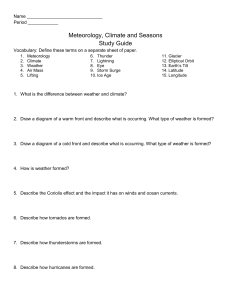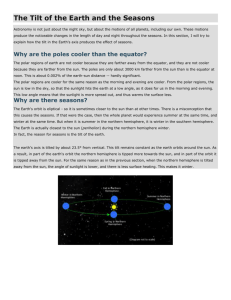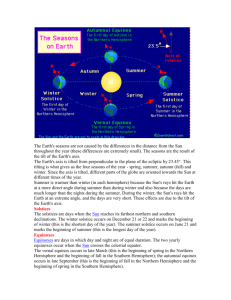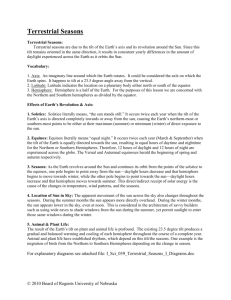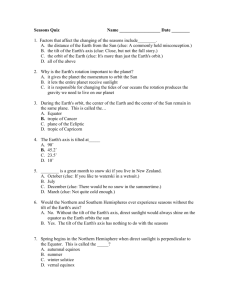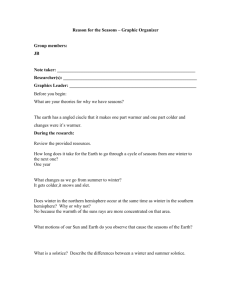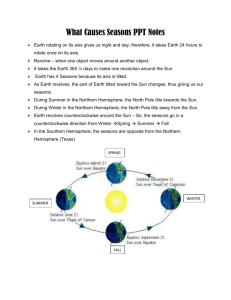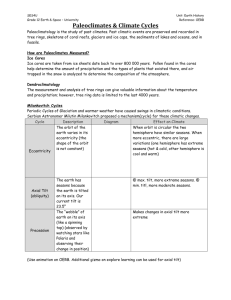TEKS 7.13A_Seasons
advertisement
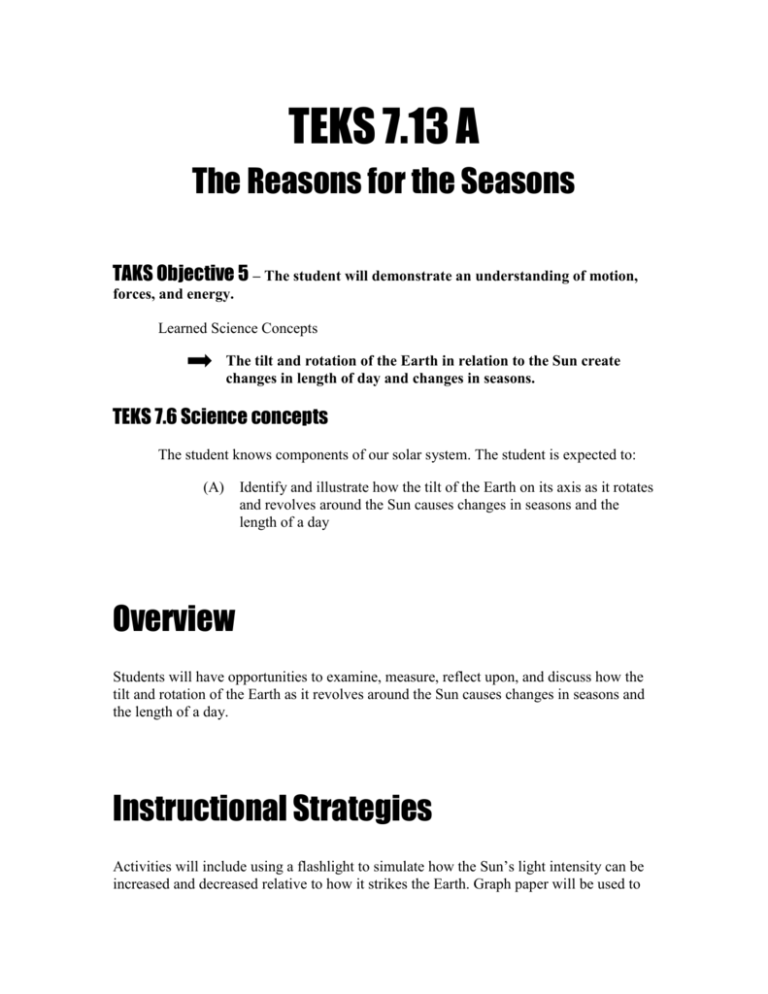
TEKS 7.13 A The Reasons for the Seasons TAKS Objective 5 – The student will demonstrate an understanding of motion, forces, and energy. Learned Science Concepts The tilt and rotation of the Earth in relation to the Sun create changes in length of day and changes in seasons. TEKS 7.6 Science concepts The student knows components of our solar system. The student is expected to: (A) Identify and illustrate how the tilt of the Earth on its axis as it rotates and revolves around the Sun causes changes in seasons and the length of a day Overview Students will have opportunities to examine, measure, reflect upon, and discuss how the tilt and rotation of the Earth as it revolves around the Sun causes changes in seasons and the length of a day. Instructional Strategies Activities will include using a flashlight to simulate how the Sun’s light intensity can be increased and decreased relative to how it strikes the Earth. Graph paper will be used to simulate how the angle of the Sun affects the amount of energy transferred to the Earth at different latitudes. Planetarium models may be used to elaborate these concepts. Objectives 1. Without assistance, the student will describe how the tilt of the Earth causes the seasons to occur. A minimum score of 70% on the rubric is required. For Teacher’s Eyes Only The Reasons for the Seasons The Earth’s seasons are caused by the tilt of the Earth’s axis, NOT the differences in distance from the Sun, which are extremely small. The Earth’s axis is tilted 23.45 degrees from the perpendicular to the plane on which the earth revolves around the Sun (Figure 1). The tilting of the axis is responsible for the four seasons of the year: spring, summer, autumn (fall), and winter. The tilt causes different parts of the earth to be oriented towards the sun during different times of the year.1 As shown in Figure 2, each hemisphere’s summer is warmer than its winter because (1) during the summer the Sun’s rays hit that hemisphere at a more direct angle than during the winter and (2) in the summer the days are much longer than the nights (the length of day and night is also caused by the Earth’s tilt; more on this later).1 1 http://www.enchantedlearning.com/subjects/astronomy/planets/earth/Seasons.shtml. How the Earth’s Tilt Causes the Seasons – Part 1: The Spread of the Sun’s Rays on the Earth When the Sun’s rays do not hit a location directly, they are more spread out and hence less concentrated. Think of the Sun’s light like the light from a flashlight. The flashlight gives out a set amount of light. If you point the flashlight directly at the wall, you get a concentrated circle of light, whereas if you point it at an angle to the floor, you get a spread out ellipse of less concentrated light (Figure 3). The ellipse covers a larger area than the circle, but contains the same amount of light. The direct light in the circle is more concentrated and intense because it is less spread out. Figure 3 The Solstices The summer solstice occurs June 21. It marks the beginning of summer in the Northern Hemisphere and is the longest day (and shortest night) of the year. Also, during this time, the northern hemisphere is maximally oriented towards the sun. The winter solstice occurs December 21 or 22 (it varies a little because it doesn’t take the Earth exactly 365 days to make one trip around the Sun; leap years cause the date to vary). It marks the beginning of winter Northern Hemisphere and is the shortest day (and longest night) of the year. Also, during this time, the Northern Hemisphere is maximally oriented away from the sun. The Equinoxes The equinoxes (think equal) are days of equal duration day and night. During these periods, the equator receives the Sun’s rays most directly. The vernal equinox (the word vernal also means “fresh, new, or youthful”) occurs in late March and marks the beginning of spring in the Northern Hemisphere. The autumnal equinox occurs in late September and marks the beginning of autumn/fall in the Northern Hemisphere. How the Earth’s Tilt Causes the Seasons – Part 2: The Lengths of Days and Nights The second cause of seasonal changes is the length of day, which is also caused by the tilt of the Earth’s axis. During the summer for a hemisphere, more of that hemisphere is in light than darkness (Figure 4). The exact amount by which day is longer than 12 hours depends on how far north one is from the equator, with length of day increasing the further north you go. For example, when it is summer solstice for the Northern hemisphere, daytime in Chicago, Illinois lasts about 15 hours (and night only 9 hours).1 In Barrow, Alaska, daytime lasts a full 24 hours during summer solstice2 (this is true because above a certain latitude, 180 degrees around the earth are bathed in light)! 1 2 http://scienceworld.wolfram.com/astronomy/SummerSolstice.html, http://www.gi.alaska.edu/ScienceForum/ASF12/1239.html Figure 4. Summer in the Northern Hemisphere: Night Day Red Line – Earth’s Axis Blue Line – Earth’s Equator Dashed Line – the perpendicular to the plane on which the Earth travels around the Sun. The Equator The equator is warm all year round because, on average, it receives the most direct light from the sun. Also note that the equator has equal length days and nights no matter the time of the year. Exactly half the equator is in light and half is in darkness no matter where the Earth is in its course around the sun. The means that seasons at the equator are only caused by one factor: the varying spread of the suns rays on the earth caused by the tilt of the earth. As you get further away from the equator, the more day and night varies over the year and the more pronounced the seasons become. More things to think about… The two hemispheres experience opposite seasons; when it is summer for the Northern Hemisphere, it is winter for the Southern Hemisphere, and vice versa. When it is spring for the Northern Hemisphere, it is autumn/fall for the Southern Hemisphere, and vice versa. Think about it – when the Northern Hemisphere is maximally oriented towards the Sun (23.45 degrees), the Southern Hemisphere is maximally oriented away from the Sun, (and vice versa, of course!). Student Misconceptions Misconception Seasons are the result of changes in the distance between the Sun and the Earth. For example, during winter, the Earth is farther away from the Sun. Science Concept The Earth orbits the Sun in an elliptial path. However, changes in seasons are not the result of the path. Actually, Earth’s orbit is nearly a perfect circle. Rebuild Concept Use simulations or planetariums to investigate the effect of distance between the Earth and Sun. Misconception Seasons are the result of the tilt of the Earth. Science Concept The tilt of the Earth does not result in any significant changes with regard to the distance between the Earth and the Sun. Rebuild Concept Use simulations or planetariums to investigate how the tilt of the Earth Student Prior Knowledge TEKS 13 (A) The student is able to identify characteristics of objects in our solar system incoluding the Sun, planets, meteorites, comets, asteroids, and moons. 5 E’s Engage Use a flashlight and shine it directly on the wall. Tilt the angle of the flashlight to create an elipitical pattern of light on the wall. Ask student how this might relate to the change of the seasons. Explore Given a flashlight and graph paper, students will work in groups and simulate how the angle of the sun affects the amount of energy transferred to the earth at different latitudes. Place the graph paper on the desk and hold the flashlight 20 cm. directly above (perpendicular to) the graph paper (Figure 3). Outline the pattern of light on the graph paper. Then, place the flashlight 20 cm. at an angle above the graph paper and shine the light on the graph paper at an angle of approximately 20˚. Outline the pattern of light on the graph paper. Find the ratio of squares in each drawing to 100 lumens of light. Which is the most concentrated? The teacher will assist students during the simulation as needed. Elaborate Order A Private Universe http://www.learner.org/catalog/series28.html OR show the free video clips from A Private Universe. Ask the students to identify the misconceptions shown in the clip and explain the correct concept. http://www.learner.org/teacherslab/pup/class_acts_movie.html http://www.learner.org/teacherslab/pup/about_acts_movie.html Explain The Earth’s seasons are caused by the tilt of the Earth’s axis, NOT the differences in distance from the Sun, which are extremely small. The Earth’s axis is tilted 23.45 degrees from the perpendicular to the plane on which the earth revolves around the Sun. The tilting of the axis is responsible for the four seasons of the year: spring, summer, autumn (fall), and winter. The tilt causes different parts of the earth to be oriented towards the sun during different times of the year.1 Each hemisphere’s summer is warmer than its winter because (1) during the summer the Sun’s rays hit that hemisphere at a more direct angle than during the winter and (2) in the summer the days are much longer than the nights (the length of day and night is also caused by the Earth’s tilt.1 1 http://www.enchantedlearning.com/subjects/astronomy/planets/earth/Seasons.shtml. Evaluate Use the misconceptions test from the following website: http://www.learner.org/teacherslab/pup/studentquestions.html AND/OR The student will describe in at least 150 words and a 2-line drawing what causes seasons to occur. The Reasons for the Seasons Rubric Drawing correctly shows less than 5 of the following: winter solstice, summer solstice, spring equinox, vernal equinox, position of sun, and tilt of earth. No or incoherent explanation of what causes seasons Student’s explanation is less than 100 words. Revise and Resubmit Drawing correctly shows at least 5 or 6 of the following: winter solstice, summer solstice, spring equinox, vernal equinox, position of sun, and tilt of earth. Explanation includes either the title of the earth or the differential heating of the earth by the sun. Student provides an explanation of at least 100 words 70% Drawing correctly shows all of the following: winter solstice, summer solstice, spring equinox, vernal equinox, position of sun, and tilt of earth. Explanation includes the tilt of earth and differential heating of the earth by the sun. Student provides an explanation of at least 150 words 100%

